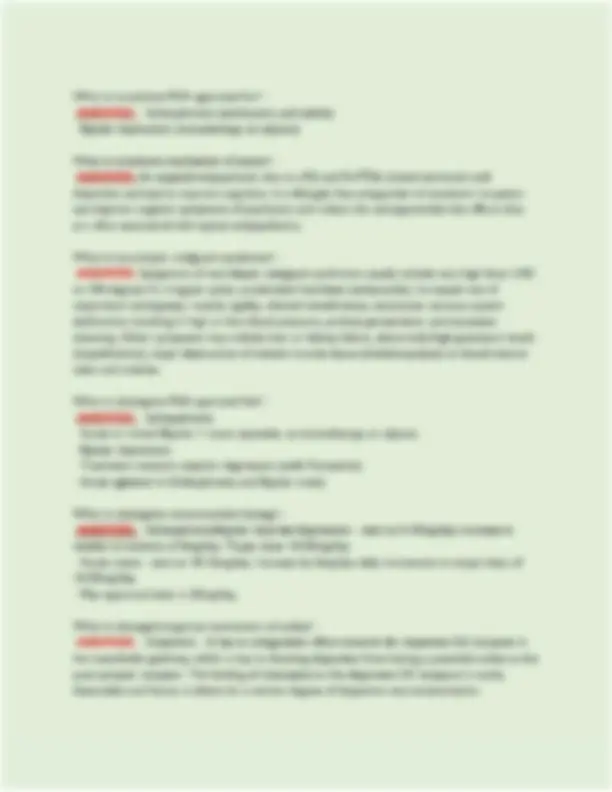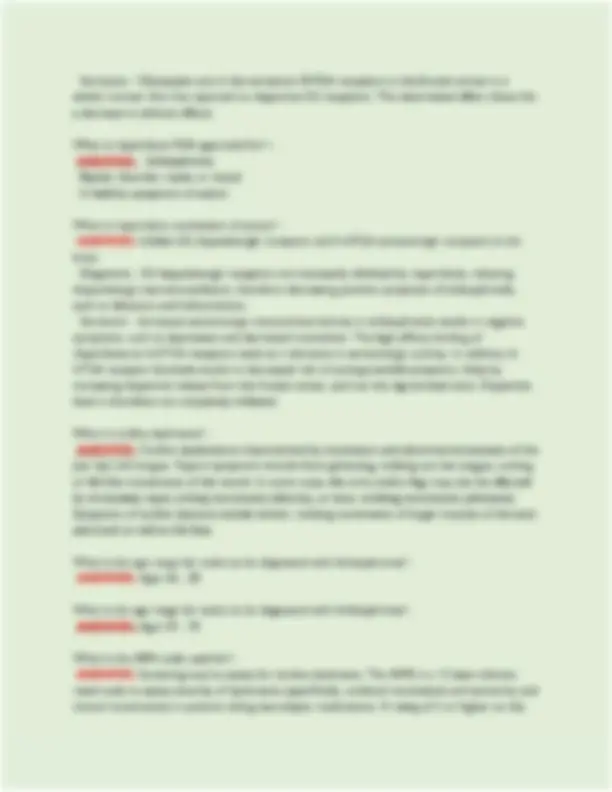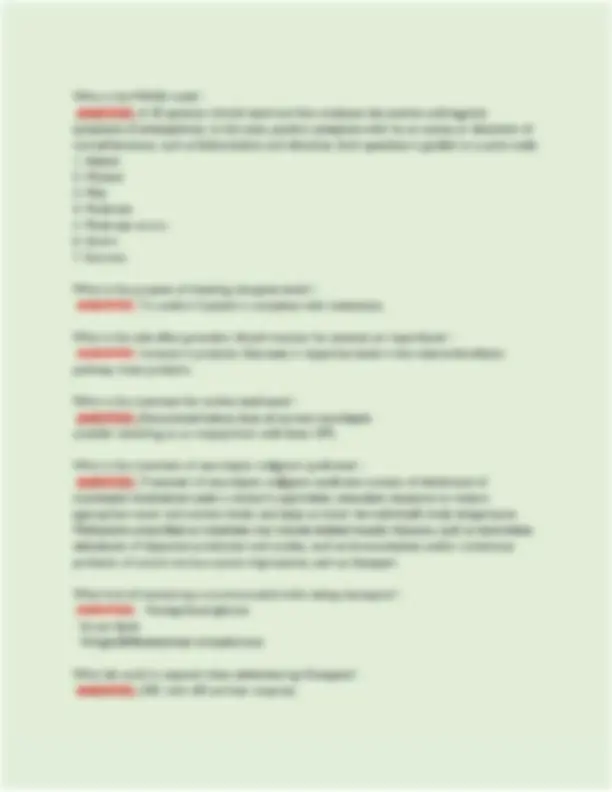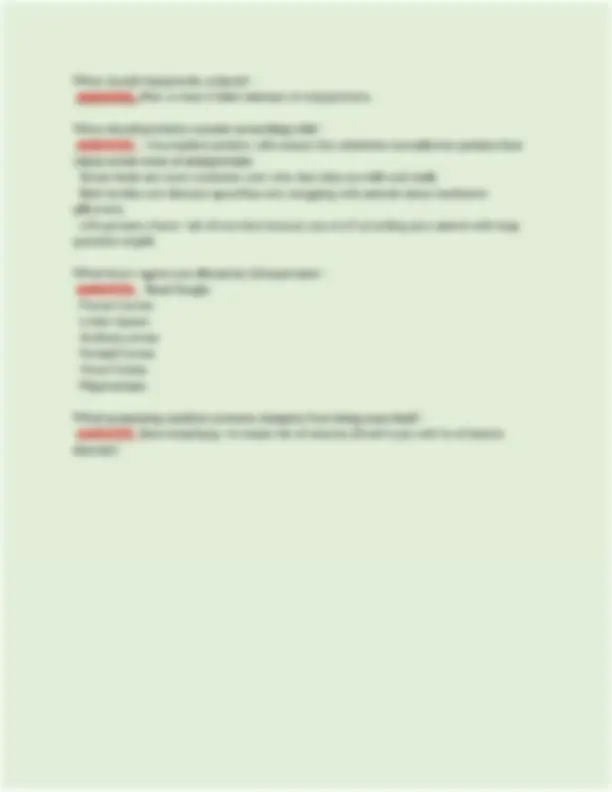Partial preview of the text
Download NU665C/ NU 665C Exam 1 (Latest 2025/ 2026 Update) Psychiatric Mental Health Care of the Fa and more Exams Nursing in PDF only on Docsity!
NU665C/ NU 665C Exam | Psychiatric Mental Health Care of the Family II Review| Questions & Answers| Grade A| 100% Correct (Verified Solutions)- Regis College Does lurasidone cause weight gain? - ANSWER: No risk for weight gain due to the low affinity for serotonin and higher affinity for dopamine. How does nicotine affect clozapine in the body? - ANSWER: It lowers clozapine levels. Dose may need to be titrated up for therapeutic effect. How often should CBC with diff be ordered for patients on Clozapine? - ANSWER: - Baseline before starting clozapine -Weekly for 6 months - Every 2 weeks for 6 months -Monthly after 12 months What Absolute neutrophil count (ANC) level is acceptable to prescribe clozapine? - ANSWER: ANC must be equal to or greater than 1500; For Benign Ethnic Neutropenia population, ensure two baseline ANCs equal to or greater than 1000. What are delusions of grandeur? - ANSWER: Delusions, or false beliefs, comes in several types. Delusions of grandeur are one of the more common ones. It's when you believe that you have more power, wealth, smarts, or other grand traits than is true. Some delusions might be about events that possibly could have happened, but actually didn't or were exaggerated. Other delusions are clearly bizarre, such as insisting that an alien lives in your fridge. Someone with grandiose delusions is unshakably convinced that their delusions are true. What are delusions of reference? - ANSWER: Ideas of reference and delusions of reference describe the phenomenon of an individual experiencing innocuous events or mere coincidences and believing they have strong personal significance. False belief that public events or people are directly related to the individual. What are erotomatic delusions? - ANSWER: Erotomania is when you think someone is in love with you but they're not. It may be a person you've never met. They might even be famous, like a politician or an actor. You can be so sure of this love that you think you're in a relationship with this person. You may not be able to accept facts that prove otherwise. What are persecutory delusions? - ANSWER: Persistent, troubling, false beliefs that one is about to be harmed or mistreated by others in some way. These beliefs occur in some people with delusional disorder, a rare mental illness, and cause significant distress, including anxiety, depression, and fear. What are somatic delusions? - ANSWER: People with somatic delusions are completely convinced there is something medically, physically, or biologically wrong with them, and their belief is so strong and sincere they will experience a range of "symptoms" that verify their worst fears. What are the side effects of lurasidone? - ANSWER: - Sedation, agitation and akathisia - Orthostatic hypotension and syncope are serious but rare side effects. What are the side effects of olanzapine? - ANSWER: - Metabolic syndrome (high blood sugar/diabetes, increased lipid panel) - Weight gain - DKA in patients with preexisting diabetes (Avoid) - Common symptoms are somnolence, dry mouth, increased appetite, EPS symptoms What are the types of Hallucination? - ANSWER: Auditory, visual, olfactory, tactile, gustatory, somatic. What is a dissociative episode? - ANSWER: You are in a dissociative trance. This means you have very little awareness of things you are doing or happening around you. Or you might not respond to things and people around you because of trauma. Short but severe episodes. Could be triggered by one or more stressful events. What is akathisia and how is it treated? - ANSWER: When people cannot sit still. Must constantly be moving around. Restless. feels like ants in the pants Tx: Benztropine or Ativan What is Capgras syndrome? - ANSWER: A rare condition in which someone believes that their loved ones or others they know have been replaced with doubles or imposters. The belief is so real that nothing can correct this illusion. What is lurasidone FDA approved for? - ANSWER: - Schizophrenia (adolescents and adults) - Bipolar depression (monotherapy or adjunct) What is lurasidone mechanism of action? - ANSWER: An atypical antipsychotic that is a D2 and 5-HT2A (mixed serotonin and dopamine activity) to improve cognition. It is thought that antagonism of serotonin receptors can improve negative symptoms of psychoses and reduce the extrapyramidal side effects that are often associated with typical antipsychotics. What is neuroleptic malignant syndrome? - ANSWER: Symptoms of neuroleptic malignant syndrome usually include very high fever (102 to 104 degrees F), irregular pulse, accelerated heartbeat (tachycardia), increased rate of respiration (tachypnea), muscle rigidity, altered mental status, autonomic nervous system dysfunction resulting in high or low blood pressure, profuse perspiration, and excessive sweating. Other symptoms may include liver or kidney failure, abnormally high potassium levels (hyperkalemia), major destruction of skeletal muscle tissue (rhabdomyolysis) or blood clots in veins and arteries. What is olanzapine FDA approved for? - ANSWER: - Schizophrenia - Acute or mixed Bipolar | manic episodes, as monotherapy or adjunct. - Bipolar depression - Treatment resistant unipolar depression (with Fluoxetine) : Acute agitation in Schizophrenia and Bipolar mania What is olanzapine recommended dosing? - ANSWER: - Schizophrenia/bipolar disorder/depression - start at 5-1 Omg/day; increase in weekly increments of 5mg/day. Target dose 10-20mg/day. - Acute mania - start at 10-1 5mg/day. Increase by 5mg/day daily increments to target dose of 10-20mg/day. Max approved dose is 20mg/day. What is olanzapine/zyprexa mechanism of action? - ANSWER: - Dopamine - It has an antagonistic effect towards the dopamine D2 receptor in the mesolimbic pathway which is key to blocking dopamine from having a potential action at the post-synaptic receptor. The binding of olanzapine to the dopamine D2 receptors is easily dissociable and hence, it allows for a certain degree of dopamine neurotransmission. - Serotonin - Olanzapine acts in the serotonin 5HT2A receptors in the frontal cortex in a similar manner than the reported on dopamine D2 receptors. This determined effect allows for a decrease in adverse effects. What is risperidone FDA approved for? - AN ER: - Schizophrenia - Bipolar disorder; manic or mixed ‘Irritability symptoms of autism What is risperidone mechanism of action? - ANSWER: Inhibits D2 dopaminergic receptors and 5-HT2A serotonergic receptors in the brain. - Dopamine - D2 dopaminergic receptors are transiently inhibited by risperidone, reducing dopaminergic neurotransmission, therefore decreasing positive symptoms of schizophrenia, such as delusions and hallucinations. - Serotonin - Increased serotonergic mesocortical activity in schizophrenia results in negative symptoms, such as depression and decreased motivation. The high-affinity binding of risperidone to 5-HT2A receptors leads to a decrease in serotonergic activity. In addition, 5- HT2A receptor blockade results in decreased risk of extrapyramidal symptoms, likely by increasing dopamine release from the frontal cortex, and not the nigrostriatal tract. Dopamine level is therefore not completely inhibited. What is tardive dyskinesia? - ANSWER: Tardive dyskinesia is characterized by involuntary and abnormal movements of the jaw, lips and tongue. Typical symptoms include facial grimacing, sticking out the tongue, sucking or fish-like movements of the mouth. In some cases, the arms and/or legs may also be affected by involuntary rapid, jerking movements (chorea), or slow, writhing movements (athetasis). Symptoms of tardive dystonia include slower, twisting movements of larger muscles of the neck and trunk as well as the face. What is the age range for males to be diagnosed with Schizophrenia? - ANSWER: Ages 16 - 25 What is the age range for males to be diagnosed with Schizophrenia? - ANSWER: Ages 25 - 35 What is the AIMs scale used for? - ANSWER: Screening tool to assess for tardive dyskinesia. The AIMS is a |2-item clinician rated scale to assess severity of dyskinesias (specifically, orofacial movements and extremity and truncal movements) in patients taking neuroleptic medications. A rating of 2 or higher on the What is the DSM criteria for schizophreniform disorder? - ANSWER: A. Two (or more) of the following, each present for a significant portion of time during a |-month period (or less if successfully treated). At least one of these must be (1), (2), or (3): 1. Delusions 2. Hallucinations 3. Disorganized speech (e.g., frequent derailment or incoherence). 4. Grossly disorganized or catatonic behavior 5. Negative symptoms (i.e., diminished emotional expression or avolition). B. Impairs person's personal life C. Lasts between | to 6 months. D. NO MOOD SWINGS E, Not related to a substance. What is the DSM-5 criteria for illness anxiety disorder? - ANSWER: Constantly preoccupied with an illness. Constantly think they are sick. A. Preoccupation with having or acquiring a serious illness. B. Somatic symptoms are not present or, if present, are only mild in intensity. If another medical condition is present or there is a high risk for developing a medical condition (e.g., strong family history is present), the preoccupation is clearly excessive or dis-proportionate. C. There is a high level of anxiety about health, and the individual is easily alarmed about personal health status. D. The individual performs excessive health-related behaviors (e.g., repeatedly checks his or her body for signs of illness) or exhibits maladaptive avoidance (e.g., avoids doctor appointments and hospitals). E. Illness preoccupation has been present for at least 6 months, but the specific illness that is feared may change over that period of time. What is the DSM-5 criteria for somatic symptom disorder? - ANSWER: Symptom manifestation is not intentional. A. One or more somatic symptoms that are distressing or result in significant disruption of daily life. B. Excessive thoughts, feelings, or behaviors related to the somatic symptoms or associated health concerns as manifested by at least one of the following: - Disproportionate and persistent thoughts about the seriousness of one's symptoms. - Persistently high level of anxiety about health or symptoms. - Excessive time and energy devoted to these symptoms or health concerns. C. Although any one somatic symptom may not be continuously present, the state of being symptomatic is persistent (typically more than 6 months). What is the PANSS scale? - ANSWER: A 30 question clinical rated tool that evaluates the positive and negative symptoms of schizophrenia. In this scale, positive symptoms refer to an excess or distortion of normal functions, such as hallucinations and delusions. Each questions is graded on a point scale: |. Absent 2. Minimal 3. Mild 4. Moderate 5. Moderate severe 6. Severe 7. Extreme What is the purpose of checking clozapine levels? - ANSWER: To confirm if patient is compliant with medication. What is the side effect providers should monitor for patients on risperidone? - ANSWER: Increase in prolactin. Decrease in dopamine levels in the tuberoinfundibular pathway raises prolactin. What is the treatment for tardive dyskinesia? - ANSWER: Discontinue/reduce dose of current neuroleptic consider switching to an antipsychotic with fewer EPS. What is the treatment of neuroleptic malignant syndrome? - ANSWER: Treatment of neuroleptic malignant syndrome consists of withdrawal of neuroleptic medications under a doctor's supervision, immediate measures to restore appropriate water and nutrient levels, and steps to lower the individual's body temperature. Medications prescribed as treatment may include skeletal muscle relaxants, such as dantrolene; stimulators of dopamine production and activity, such as bromocriptine; and/or continuous perfusion of central nervous system depressants, such as diazepam. What kind of monitoring is recommended while taking olanzapine? - ANSWER: - Fasting blood glucose - Serum lipids - Weight/BMI/abdominal circumference What lab work is required when administering Clozapine? - ANSWER: CEC with diff and liver enzymes. When should clozapine be ordered? - ANSWER: After at least 2 failed attempts of antipsychotics. When should providers consider prescribing LAls? - ANSWER: - Uncompliant patients. LAls ensure that otherwise non-adherent patients have robust serum levels of antipsychotics. -Serum levels are more consistent over time than they are with oral meds. - Both families and clinicians spend less time struggling with patients about medication adherence. - LAls present a lower risk of overdose because you aren't providing your patient with large quantities of pills. Which brain regions are affected by Schizophrenia? - ANSWER: - Basal Ganglia - Frontal Cortex - Limbic System - Auditory cortex - Parietal Cortex Visual Cortex - Hippocampus Which preexisting condition prevents clozapine from being prescribed? - WER: Seizures/epilepsy. Increases risk of seizures (Avoid in pts with hx of seizure disorder) 



















